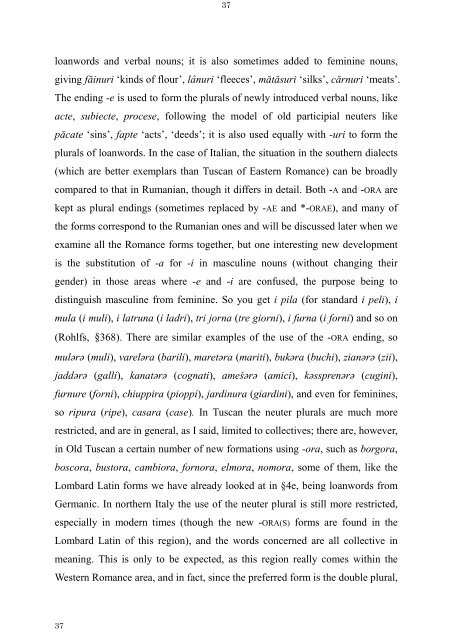The Latin Neuter Plurals in Romance - Page ON
The Latin Neuter Plurals in Romance - Page ON
The Latin Neuter Plurals in Romance - Page ON
Create successful ePaper yourself
Turn your PDF publications into a flip-book with our unique Google optimized e-Paper software.
37<br />
37<br />
loanwords and verbal nouns; it is also sometimes added to fem<strong>in</strong><strong>in</strong>e nouns,<br />
giv<strong>in</strong>g fă<strong>in</strong>uri ‘k<strong>in</strong>ds of flour’, lânuri ‘fleeces’, mătăsuri ‘silks’, cărnuri ‘meats’.<br />
<strong>The</strong> end<strong>in</strong>g -e is used to form the plurals of newly <strong>in</strong>troduced verbal nouns, like<br />
acte, subiecte, procese, follow<strong>in</strong>g the model of old participial neuters like<br />
păcate ‘s<strong>in</strong>s’, fapte ‘acts’, ‘deeds’; it is also used equally with -uri to form the<br />
plurals of loanwords. In the case of Italian, the situation <strong>in</strong> the southern dialects<br />
(which are better exemplars than Tuscan of Eastern <strong>Romance</strong>) can be broadly<br />
compared to that <strong>in</strong> Rumanian, though it differs <strong>in</strong> detail. Both -A and -ORA are<br />
kept as plural end<strong>in</strong>gs (sometimes replaced by -AE and *-ORAE), and many of<br />
the forms correspond to the Rumanian ones and will be discussed later when we<br />
exam<strong>in</strong>e all the <strong>Romance</strong> forms together, but one <strong>in</strong>terest<strong>in</strong>g new development<br />
is the substitution of -a for -i <strong>in</strong> mascul<strong>in</strong>e nouns (without chang<strong>in</strong>g their<br />
gender) <strong>in</strong> those areas where -e and -i are confused, the purpose be<strong>in</strong>g to<br />
dist<strong>in</strong>guish mascul<strong>in</strong>e from fem<strong>in</strong><strong>in</strong>e. So you get i pila (for standard i peli), i<br />
mula (i muli), i latruna (i ladri), tri jorna (tre giorni), i furna (i forni) and so on<br />
(Rohlfs, §368). <strong>The</strong>re are similar examples of the use of the -ORA end<strong>in</strong>g, so<br />
mulərə (muli), vareləra (barili), maretəra (mariti), bukəra (buchi), zianərə (zii),<br />
jaddərə (galli), kanatərə (cognati), amešərə (amici), kəssprenərə (cug<strong>in</strong>i),<br />
furnure (forni), chiuppira (pioppi), jard<strong>in</strong>ura (giard<strong>in</strong>i), and even for fem<strong>in</strong><strong>in</strong>es,<br />
so ripura (ripe), casara (case). In Tuscan the neuter plurals are much more<br />
restricted, and are <strong>in</strong> general, as I said, limited to collectives; there are, however,<br />
<strong>in</strong> Old Tuscan a certa<strong>in</strong> number of new formations us<strong>in</strong>g -ora, such as borgora,<br />
boscora, bustora, cambiora, fornora, elmora, nomora, some of them, like the<br />
Lombard <strong>Lat<strong>in</strong></strong> forms we have already looked at <strong>in</strong> §4e, be<strong>in</strong>g loanwords from<br />
Germanic. In northern Italy the use of the neuter plural is still more restricted,<br />
especially <strong>in</strong> modern times (though the new -ORA(S) forms are found <strong>in</strong> the<br />
Lombard <strong>Lat<strong>in</strong></strong> of this region), and the words concerned are all collective <strong>in</strong><br />
mean<strong>in</strong>g. This is only to be expected, as this region really comes with<strong>in</strong> the<br />
Western <strong>Romance</strong> area, and <strong>in</strong> fact, s<strong>in</strong>ce the preferred form is the double plural,









